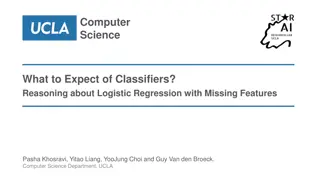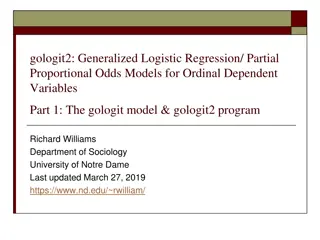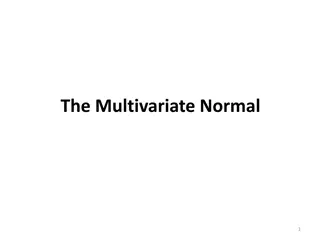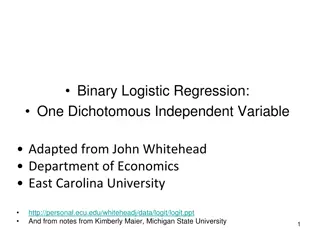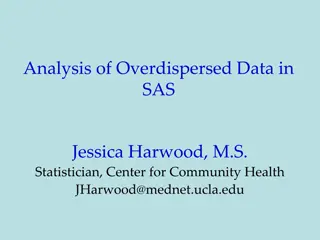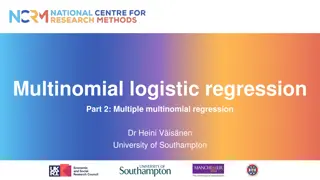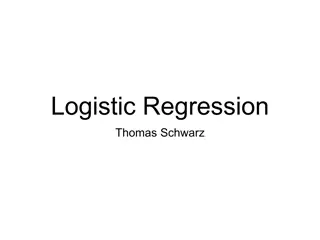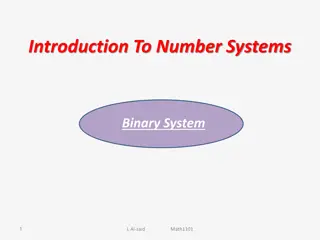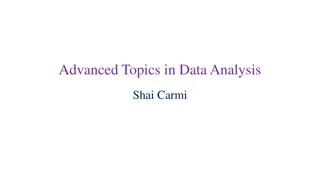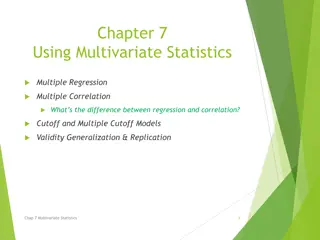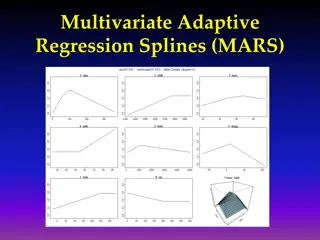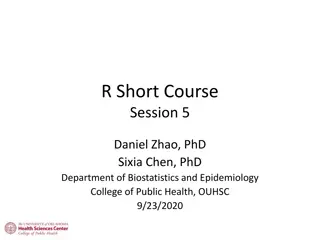Understanding Multivariate Binary Logistic Regression Models: A Practical Example
Exploring the application of multivariate binary logistic regression through an example on factors associated with receiving assistance during childbirth in Ghana. The analysis includes variables such as wealth quintile, number of children, residence, and education level. Results from the regression model are interpreted in terms of odds ratios, providing insights into the impact of these variables on the likelihood of receiving professional healthcare assistance.
Download Presentation

Please find below an Image/Link to download the presentation.
The content on the website is provided AS IS for your information and personal use only. It may not be sold, licensed, or shared on other websites without obtaining consent from the author. Download presentation by click this link. If you encounter any issues during the download, it is possible that the publisher has removed the file from their server.
E N D
Presentation Transcript
Binary logistic regression Part 2: Multivariate binary logistic regression Dr Heini V is nen University of Southampton
Outline Multiple logistic regression Model selection Wald-tests Likelihood ratio test
Multiple logistic regression We can add more than one explanatory variable to the binary logistic regression model The interpretation of the coefficients is conducted while controlling for or holding constant the other coefficients. Interpretation can be made in log-odds scale, as odds or as predicted probabilities, like before
Example: Assistance at birth Which characteristics are associated with having received assistance from a health care professional at last birth in Ghana in 2008? Following characteristics of the mother are studied: Quintile of wealth (1=poorest to 5=richest) Total number of children Place of residence (urban/rural) Education (None, primary, secondary or higher)
Descriptive statistics Variable Health professional present at birth Number of children Urban residence No education Primary education Secondary education Higher education % or mean (N) 58.07% (1245) Variable % or mean (N) Mean 3.48 (2144) Wealth: poorest 35.59% (763) Wealth: poorer 36.01% (772) Wealth: middle 23.69% (508) Wealth: richer 38.06% (816) Wealth: richest 2.24% (48) 29.52% (633) 21.97% (471) 17.49% (375) 18.19% (390) 12.83% (275)
Regression results Variable PoR: Rural (ref.) PoR: Urban Wealth: poorest (ref.) Wealth: poorer Wealth: middle Wealth: richer Wealth: richest No education Primary education Secondary education Higher education (ref.) Number of children Log-odds Odds ratio P-value 0 1.00 2.59 1.00 2.36 3.05 5.60 13.75 0.21 0.27 0.44 1.00 0.95 0.95 <0.001 0 0.86 1.11 1.72 2.62 -1.55 -1.32 -0.82 <0.001 <0.001 <0.001 <0.001 0.041 0.081 0.276 0 -0.06 0.021
Interpretation in odds scale Wealth: When controlling for education, number of children and place of residence, those in the richest quintile have 13.7 times higher odds of having had assistance at the most recent birth than those in the poorest quintile. Number of children: When controlling for [ ] each additional child reduced the odds of having had assistance at the most recent birth by 5% [0.95-1*100=-5%]
Interpretation: odds ratios more generally When interpreting the results using the odds scale, we calculate the ratio of the odds of the categories of interest hence called odds ratio (OR). For categorical variables we calculate the ORs so that we compare the other categories to the reference category. For continuous variables the OR expresses, how much the odds of Y=1 increases when X increases by one unit. You can find out the OR by calculating exp( ?)
Interpretation: probability scale Transforming log-odds to probabilities i.e. calculating fitted or predicted probabilities exp(?0+ ?1?1+ + ????) 1 + exp(?0+ ?1?1+ + ????) ? = Decide which characteristics to fix constant & at what values Means (continuous), the most common category (categorical), other values of interest, or as observed
Interpretation: probability scale What is the probability of having had assistance at birth if living in a urban area, belongs to the poorest* wealth category, has no education and has 2 children? exp(0.53 + 0.95 1 1.55 1 0.056 2) 1 + exp(0.53 + 0.95 1 1.55 1 0.056 2)= 0.458 ? = *Poorest is a reference category and thus cancels out.
Regression results Variable PoR: Rural (ref.) PoR: Urban Wealth: poorest (ref.) Wealth: poorer Wealth: middle Wealth: richer Wealth: richest No education Primary education Secondary education Higher education (ref.) Number of children Log-odds Odds ratio P-value 0 1.00 2.59 1.00 2.36 3.05 5.60 13.75 0.21 0.27 0.44 1.00 0.95 <0.001 0.95 0 0.86 1.11 1.72 2.62 -1.55 -1.32 -0.82 <0.001 <0.001 <0.001 <0.001 0.041 0.081 0.276 0 0.021 -0.06
Summary of interpretation of multiple binary logistic regression Log-odds not very intuitive Odds ratios tell about the relative differences and apply to the entire scale (for continuous variables) Probabilities tell about the absolute levels of risk Need to decide at which values the variables are held Does not apply to the entire scale of a continuous variable Often the most intuitive option Usually calculated using software (Stata, SPSS, R )
Model selection: Wald-tests Wald-test is analogous to t-test in OLS regression For continuous and binary variables can be used to assess statistical significance For dummy variables with 3+ categories Wald-test shows whether each category significantly different from the reference category.
Regression results Variable PoR: Rural (ref.) PoR: Urban Wealth: poorest (ref.) Wealth: poorer Wealth: middle Wealth: richer Wealth: richest No education Primary education Secondary education Higher education (ref.) Number of children Log-odds Odds ratio P-value 0 1.00 2.59 1.00 2.36 3.05 5.60 13.75 0.21 0.27 0.44 1.00 0.95 0.95 <0.001 0 0.86 1.11 1.72 2.62 -1.55 -1.32 -0.82 <0.001 <0.001 <0.001 <0.001 0.041 0.081 0.276 0 -0.06 0.021
Likelihood Ratio Test (LR test) In logistic regression model the estimates are found by maximising the log-likelihood (LL) The higher the LL, the better the model fits the data. Difference between -2LL for two nested models can be tested The difference follows a Chi-squared distribution Degrees of freedom is the difference in the number of parameters in each model The more complicated model always has a smaller -2LL but is this reduction significant? Particularly useful for dummy-variables with more than two categories.
Likelihood ratio test Let s compare two models of having had assistance in last birth: Model 1: Number of children as the only explanatory variable. Model 2: Number of children and Wealth as explanatory variables. We can compare any two models so long as one is nested in the other. In this case Model 1 is nested in Model 2. H0: No difference between the models. H1: There is a difference between the models
Likelihood Ratio Test: calculating by hand Model 1 (number of children only) LL = -1410.12 Model 2 (both variables included) LL = -1142.94 -2LL = -2* (-1410.12) = 2820.24 -2LL = -2* (-1142.94) = 2285.88 Likelihood Ratio Test statistic = 2820.24 2285.88 = 534.36 4 d.f. (wealth has 5 categories, 1 ref.) p<0.001
Summary of model selection Likelihood ratio test is the most important tool for comparing models. Wald test can be used to get information of statistical significance of individual covariates. Let theory & previous research guide you in selecting which variables an in which order to include them in the model.





